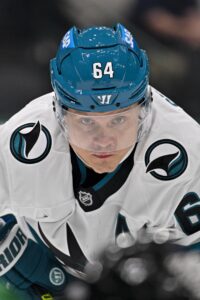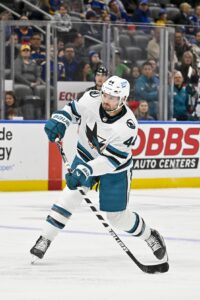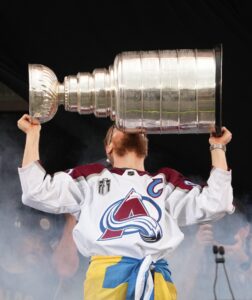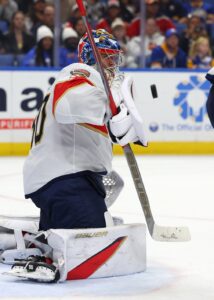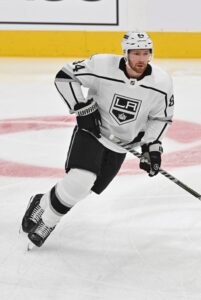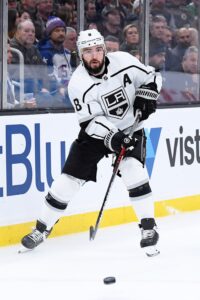The 2025 World Junior Championship is just around the corner. This year’s edition of the tournament, which takes place in Ottawa, will start on Boxing Day (Dec. 26) as usual. Most NHL fans looking to tune into the tournament will want to focus on Group A action – Finland, Canada and the United States comprise three-fifths of that group while Sweden is the only true NHL-heavy squad in Group B, although Czechia and Slovakia have a decent amount of NHL representation there.
Every one of the 10 squads participating in the tournament has at least one NHL-drafted player on their roster, although, in the case of relegation favorite Kazakhstan in Group B, it is just the lone representative. Out of the NHL’s 32 squads, only the Bruins don’t have a prospect suiting up in the tournament.
Wondering which countries to keep an eye on to track your team’s prospects? Here’s a list of every club’s prospects that are competing in the tournament:
Anaheim Ducks
F Austin Burnevik / USA / 2024, 6-182
D Vojtěch Port / Czechia / 2023, 6-161
F Carey Terrance / USA / 2023, 2-59
D Darels Uļjanskis / Latvia / 2024, 7-214
Buffalo Sabres
F Konsta Helenius / Finland / 2024, 1-14
D Adam Kleber / USA / 2024, 2-42
D Norwin Panocha / Germany / 2023, 7-205
D Maxim Štrbák / Slovakia / 2023, 2-45
F Anton Wahlberg / Sweden / 2023, 2-39
F Brodie Ziemer / USA / 2024, 3-71
Calgary Flames
D Axel Hurtig / Sweden / 2023, 7-208
Carolina Hurricanes
F Bradly Nadeau / Canada / 2023, 1-30
F Felix Unger Sörum / Sweden / 2023, 2-62
F Oskar Vuollet / Sweden / 2024, 5-133
Chicago Blackhawks
F Jiří Felcman / Czechia / 2023, 3-93
F Oliver Moore / USA / 2023, 1-19
Colorado Avalanche
F Calum Ritchie / Canada / 2023, 1-27
Columbus Blue Jackets
F Luca Pinelli / Canada / 2023, 4-114
G Melvin Strahl / Sweden / 2023, 5-156
Dallas Stars
F Emil Hemming / Finland / 2024, 1-29
D Aram Minnetian / USA / 2023, 4-125
Detroit Red Wings
G Trey Augustine / USA / 2023, 2-41
F Jesse Kiiskinen / Finland / 2023, 3-68
D Axel Sandin-Pellikka / Sweden / 2023, 1-17
Edmonton Oilers
D Beau Akey / Canada / 2023, 2-56
D Paul Fischer / USA / 2023, 5-138
Florida Panthers
F Linus Eriksson / Sweden / 2024, 2-58
Los Angeles Kings
D Jakub Dvořák / Czechia / 2023, 2-54
G Carter George / Canada / 2024, 2-57
G Hampton Slukynsky / USA / 2023, 4-118
Minnesota Wild
D Zeev Buium / USA / 2024, 1-12
D Aron Kiviharju / Finland / 2024, 4-122
F Rasmus Kumpulainen / Finland / 2023, 2-53
D Sebastian Soini / Finland / 2024, 5-140
Montreal Canadiens
D Rasmus Bergqvist / Sweden / 2024, 7-224
Nashville Predators
F David Edstrom / Sweden / 2023, 1-32
D Andrew Gibson / Canada / 2023, 2-42
D Viggo Gustafsson / Sweden / 2024, 3-77
G Jakub Milota / Czechia / 2024, 4-99
D Tanner Molendyk / Canada / 2023, 1-24
F Felix Nilsson / Sweden / 2023, 2-43
F Teddy Stiga / USA / 2024, 2-55
F Joey Willis / USA / 2023, 4-111
New Jersey Devils
F Herman Träff / Sweden / 2024, 3-91
New York Islanders
F Cole Eiserman / USA / 2024, 1-20
G Marcus Gidlöf / Sweden / 2024, 5-147
F Danny Nelson / USA / 2023, 2-49
F Jesse Nurmi / Finland / 2023, 4-113
New York Rangers
D Drew Fortescue / USA / 2023, 3-90
F Rico Gredig / Switzerland / 2024, 6-191
F Gabe Perreault / USA / 2023, 1-23
Ottawa Senators
G Vladimir Nikitin / Kazakhstan / 2023, 7-207
Philadelphia Flyers
F Jack Berglund / Sweden / 2024, 2-51
G Carson Bjarnason / Canada / 2023, 2-51
D Oliver Bonk / Canada / 2023, 1-22
F Jett Luchanko / Canada / 2024, 1-13
F Heikki Ruohonen / Finland / 2024, 4-107
Pittsburgh Penguins
F Tanner Howe / Canada / 2024, 2-46
D Kalle Kangas / Finland / 2023, 7-223
D Emil Pieniniemi / Finland / 2023, 3-91
San Jose Sharks
D Sam Dickinson / Canada / 2024, 1-11
F Kasper Halttunen / Finland / 2023, 2-36
G Christian Kirsch / Switzerland / 2024, 4-116
F Brandon Svoboda / USA / 2023, 3-71
Seattle Kraken
F Berkly Catton / Canada / 2024, 1-8
D Jakub Fibigr / Czechia / 2024, 7-202
F Zeb Forsfjäll / Sweden / 2023, 6-180
F Julius Miettinen / Finland / 2024, 2-40
D Caden Price / Canada / 2023, 3-84
F Carson Rehkopf / Canada / 2023, 2-50
G Kim Saarinen / Finland / 2024, 3-88
F Eduard Šalé / Czechia / 2023, 1-20
St. Louis Blues
F Adam Jecho / Czechia / 2024, 3-95
D Adam Jiříček / Czechia / 2024, 1-16
F Ondřej Kos / Czechia / 2024, 3-81
D Theo Lindstein / Sweden / 2023, 1-29
F Juraj Pekarčík / Slovakia / 2023, 3-76
D Colin Ralph / USA / 2024, 2-48
F Jakub Štancl / Czechia / 2023, 4-106
F Otto Stenberg / Sweden / 2023, 1-25
Tampa Bay Lightning
F Ethan Gauthier / Canada / 2023, 2-37
F Joona Saarelainen / Finland / 2024, 5-149
Toronto Maple Leafs
F Easton Cowan / Canada / 2023, 1-28
F Miroslav Holinka / Czechia / 2024, 5-151
Utah Hockey Club
F Cole Beaudoin / Canada / 2024, 1-24
G Michael Hrabal / Czechia / 2023, 2-38
F Vojtěch Hradec / Czechia / 2024, 6-167
G Melker Thelin / Sweden / 2023, 5-134
D Veeti Väisänen / Finland / 2024, 3-96
Vancouver Canucks
D Sawyer Mynio / Canada / 2023, 3-89
D Basile Sansonnens / Switzerland / 2024, 7-221
D Tom Willander / Sweden / 2023, 1-11
Vegas Golden Knights
F Mathieu Cataford / Canada / 2023, 3-77
F Trevor Connelly / USA / 2024, 1-19
F Tuomas Uronen / Finland / 2023, 6-192
Washington Capitals
D Cole Hutson / USA / 2024, 2-43
F Ryan Leonard / USA / 2023, 1-8
F Ēriks Mateiko / Latvia / 2024, 3-90
D Leon Muggli / Switzerland / 2024, 2-52
F Miroslav Šatan Jr. / Slovakia / 2024, 7-212
F Petr Sikora / Czechia / 2024, 6-178
Winnipeg Jets
F Brayden Yager / Canada / 2023, 1-14


